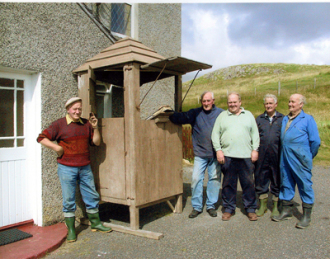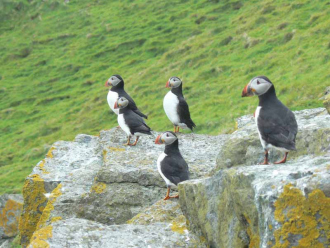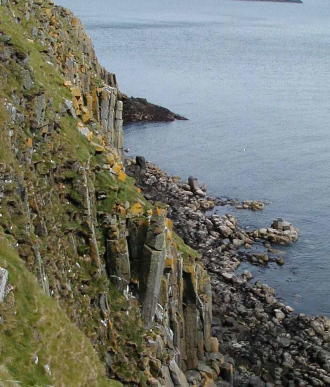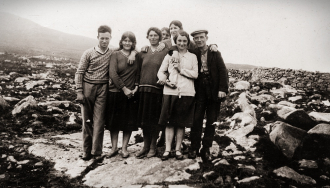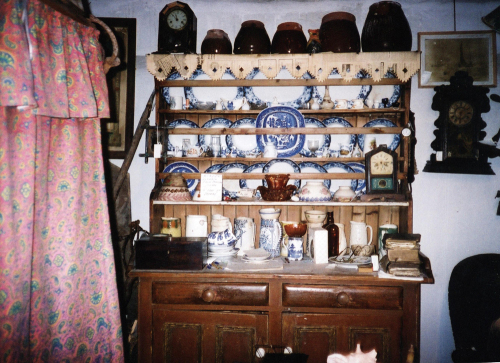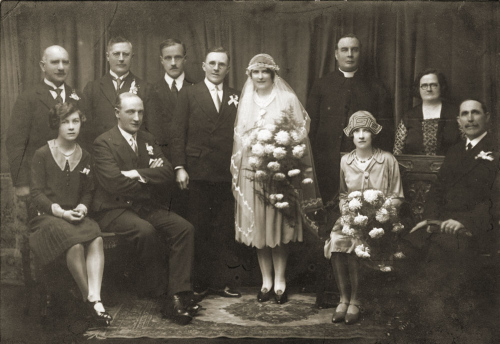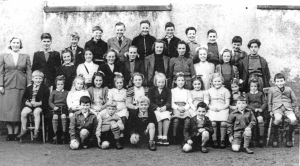In these days when village shops are all but gone it is hard to imagine that even a small village could have half a dozen shops in the early 1900’s
Buth Dhomhnull a Gharraidh (Donald Macleod) 1 Garyvard.
After the first world war Domhnull a Gharaidh set up a shoemaking business in an extension to Seoc a Gharraidh’s old black house on croft 1 next to where Roddy and Barabells house is sited today. Donald had served his time as a shoemaker in Stornoway. This soon became a gathering place (taigh ceilidh) for the local youth as well as those not so young. Card games were a common part of the evenings entertainment with ‘Catch the Ten’ being a favourite with matches as stakes. Donald soon expanded and started to trade in other commodities and eventually built a shop to sell general stores.
In 1934 he became the Postman for the area serving the villages of Habost, Kershader, Garyvard and Caversta, a service which he undertook for 28 years until he retired in the early 60’s.
By the thirties demand for handmade footwear had fallen off, but he still did shoe repairs up until the fifties. The shop was at its busiest in the forties when people came for their weekly rations and although the shop was only a 12 X 8 shed it included a butchery section. Environmental and Health & Safety standards were not an issue in those days with meat, flour, cheese, salt herring, kippers, boots, shoes, oilcake and fluke pills all being dispensed from this small shed and especially as it wasn’t unknown for the assistant to cast aside his manure creel to go and serve a customer in the shop.
Seada Thorcuill (Torcuill Macleod) 3 Garyvard
Torcuill Shiomon as he was known was a shoemaker who worked from a shed which still stands beside the steading at croft No 3. His business was confined to shoemaking mostly in the thirties. Torcuill himself died in 1944 at the age of 60.
The family had been visited by tragedy nine years earlier when two days before Christmas 1935 the three brothers, Alasdair, Calum and Calum Alasdair were out on the Caversta river which was covered with ice. Their dog slipped through a hole in the ice and whilst attempting to rescue the dog, Calum Alasdair went in under the ice and was tragically drowned aged 10 years. Alasdair tried to save his brother and was nearly drowned himself. He later received the Royal Humane Society Bravery Scroll. The scene of the tragedy is adjacent to the present cattle grid on the main road near Lake House.
Buth Mhurchaidh Buachaile, Murdo Macleod 3 Garyvard
Murchadh Buachaile who was Murdag Shiomon’s grandfather operated a shop from the family home around the turn of the century. Murdag Shiomon (Murdina Macleod) revived the family tradition in the late twenties and continued till the early sixties. Murdag was a true entrepreneur of her time. She bought and sold Harris Tweed, cattle and chickens as well as the normal provisions. She even bought a van and operated a mini mobile shop travelling throughout the local villages. Later on she branched into drapery, hardware and crockery and bought a larger van and she built a fairly large shop cum garage on the site of the present Council houses.
Torcuil Dhomhuill Thorcuil
Torcuil ran a shoemakers shop from a steading at 6 Garyvard before marrying and moving to Crossbost where he carried on his trade and also served as a postman.
An Buidhe
In earlier times another merchant used to go round the villages selling from his boat. An Buidhe lived on his boat with a deck referred to as a ‘smack’. Very little is known of his genealogy but the older generation remember him mooring his fishing smack in the bay and selling items of grocery. Local people still remember his boxes of Cochranes tea which must have been the popular blend of the time.
Buth Dhonnachaidh an Mhoir, Duncan Mackay 3 Caversta.
Duncan’s shop was by the river on the Caversta side on the croft at number 3 where the site of the shop and a wall can still be identified. Duncan was the father of the councillor Donald John Mackay who served the area for a good number of years.
Buth Alasdair Rhuaraidh, Alasdair Mackinnon
The shop was attached to his house, Sea Haven on croft number 1. Like most merchants he owned a number of boats over the years to bring goods from Stornoway. One of those was the Try Again.
Posted by cepaircadmin
